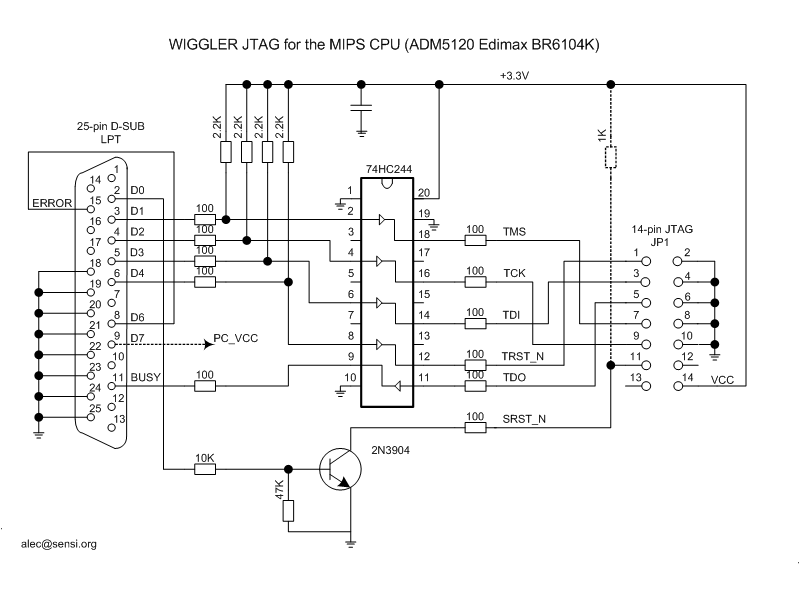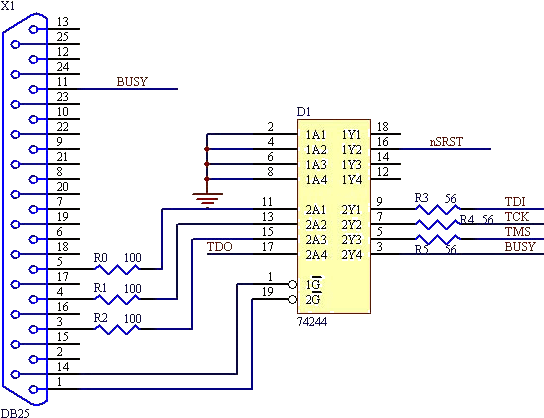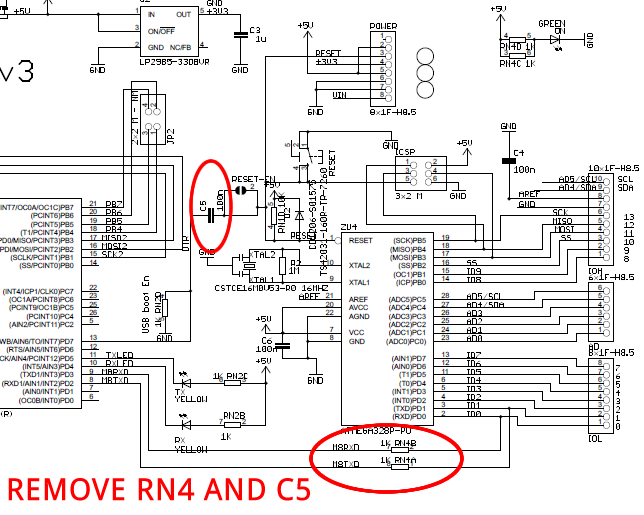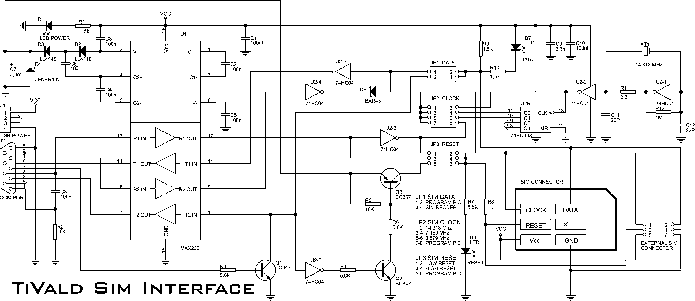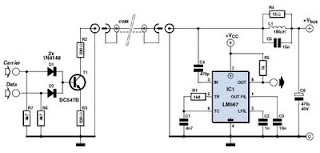
Programming Cable for Kenwood

A collection of Kenwood TK-760G-1 transceivers (two-way radios) was programmed to a single channel, with all other features locked. Various programming software for Kenwood was gathered from the internet and local newsgroups, but a programming cable was required. The initial attempt utilized a MAX232 adapter borrowed from an Atari SIOP cable, which yielded a "-PC-" message, but functionality was not achieved. Eventually, a cable was constructed based on instructions found on Russian websites. There were also rumors suggesting that an older, slower computer was necessary for programming. A P1 computer operating at 233 MHz was salvaged from local waste. After soldering the cable and connecting it, successful operation was achieved. Original transistors were not sourced; instead, refurbished transistors from an old ATX power supply (A733 and C945) were used. The cable pinout for the Kenwood 8-pin connector resembles an Ethernet port, with GND corresponding to pin 3 (or 2 for a 6-pin socket), RTXD to pin 4 (or 3), and RRXD to pin 7 (or 6). This adapter can be utilized for programming various radio types, not limited to Kenwood, but also including Motorola and other brands. This cable is referred to as a universal programming cable. AllPinouts is a web-based project that collects information on hardware interfaces, including pinouts of ports and connectors for various digital devices. The content is available under the GNU Free Documentation License (GFDL) for distribution and linking. The AllPinouts archive consists of hundreds of pages categorized into connectors, cables, and adapters.
The Kenwood TK-760G-1 transceivers are designed for two-way communication and can be programmed for specific channels and features. The programming process requires a connection via a compatible cable, which can be constructed using readily available components. The MAX232 adapter serves as a level shifter, allowing communication between the transceiver and the computer. The use of an older computer, such as the P1 at 233 MHz, is often recommended due to compatibility with the programming software that may not function well on newer systems.
The pinout configuration is critical for ensuring proper connectivity. The 8-pin connector on the Kenwood transceiver is similar in appearance to an Ethernet port, and the pin assignments must be adhered to for successful communication. The GND pin is essential for establishing a common reference voltage, while the RTXD and RRXD pins facilitate data transmission and reception, respectively. The replacement of original transistors with refurbished components from an ATX power supply suggests a cost-effective approach to maintaining functionality without sourcing specific parts.
The versatility of the universal programming cable extends its application beyond Kenwood transceivers, allowing it to be used with other brands such as Motorola. This adaptability makes it a valuable tool for technicians and hobbyists working with various two-way radio systems. The AllPinouts project serves as a comprehensive resource for understanding hardware interfaces, offering a wealth of information on pinouts and connections for a wide range of devices, which can be particularly beneficial for those involved in electronics repair and modification.I have few Kenwood TK-760G-1 transceivers (two-way radios) and they all were programmed to one channel and all other features were locked. In the internet and in local newsgroup I collected various software for Kenwood programming. All I needed is programming cable. My first attempt was with MAX232 adapter borrowed from Atari SIOP cable. I managed to get -PC- message but nothing was working. At last, I build cable exact like in some Russian internet pages. Also I hear rumour, that for programming I must use very old and slow computer. In local trash I selected P1 running at 233MHz. I soldered the cable, connected and everything is working! I didn`t find (in fact, I even didn`t tried to find) original transistors needed, so I replaced them with refurbished ones from old ATX power supply: A733 and C945 pair. Cable pinout. At Kenwood 8 pin connector like LAN (Ethernet) port or 6 pin: GND- 3(2), RTXD- 4(3), RRXD- 7(6). In brackets you can see pin numbers for 6 pin socket. As I understood from the description, this adapter can be used to program other types of radios. And not only Kenwood, but Motorola and other brands. BTW, this cable is called universal programming cable . AllPinouts is a Web-based free content project (like Wikipedia) that collects information about hardware interfaces of modern and obsolete hardware, including pinouts of ports, expansion slots, and other connectors of computers and different digital devices (i.
e. Cellular Phones, GPS, PDA, Game Consoles, etc. ). All text is available under the GNU Free Documentation License (GFDL) and may be distributed or linked accordingly. AllPinouts archive already contains hundreds of pages organized into three main categories (Connectors, Cables, Adapters) and several subcategories.
🔗 External reference
The Kenwood TK-760G-1 transceivers are designed for two-way communication and can be programmed for specific channels and features. The programming process requires a connection via a compatible cable, which can be constructed using readily available components. The MAX232 adapter serves as a level shifter, allowing communication between the transceiver and the computer. The use of an older computer, such as the P1 at 233 MHz, is often recommended due to compatibility with the programming software that may not function well on newer systems.
The pinout configuration is critical for ensuring proper connectivity. The 8-pin connector on the Kenwood transceiver is similar in appearance to an Ethernet port, and the pin assignments must be adhered to for successful communication. The GND pin is essential for establishing a common reference voltage, while the RTXD and RRXD pins facilitate data transmission and reception, respectively. The replacement of original transistors with refurbished components from an ATX power supply suggests a cost-effective approach to maintaining functionality without sourcing specific parts.
The versatility of the universal programming cable extends its application beyond Kenwood transceivers, allowing it to be used with other brands such as Motorola. This adaptability makes it a valuable tool for technicians and hobbyists working with various two-way radio systems. The AllPinouts project serves as a comprehensive resource for understanding hardware interfaces, offering a wealth of information on pinouts and connections for a wide range of devices, which can be particularly beneficial for those involved in electronics repair and modification.I have few Kenwood TK-760G-1 transceivers (two-way radios) and they all were programmed to one channel and all other features were locked. In the internet and in local newsgroup I collected various software for Kenwood programming. All I needed is programming cable. My first attempt was with MAX232 adapter borrowed from Atari SIOP cable. I managed to get -PC- message but nothing was working. At last, I build cable exact like in some Russian internet pages. Also I hear rumour, that for programming I must use very old and slow computer. In local trash I selected P1 running at 233MHz. I soldered the cable, connected and everything is working! I didn`t find (in fact, I even didn`t tried to find) original transistors needed, so I replaced them with refurbished ones from old ATX power supply: A733 and C945 pair. Cable pinout. At Kenwood 8 pin connector like LAN (Ethernet) port or 6 pin: GND- 3(2), RTXD- 4(3), RRXD- 7(6). In brackets you can see pin numbers for 6 pin socket. As I understood from the description, this adapter can be used to program other types of radios. And not only Kenwood, but Motorola and other brands. BTW, this cable is called universal programming cable . AllPinouts is a Web-based free content project (like Wikipedia) that collects information about hardware interfaces of modern and obsolete hardware, including pinouts of ports, expansion slots, and other connectors of computers and different digital devices (i.
e. Cellular Phones, GPS, PDA, Game Consoles, etc. ). All text is available under the GNU Free Documentation License (GFDL) and may be distributed or linked accordingly. AllPinouts archive already contains hundreds of pages organized into three main categories (Connectors, Cables, Adapters) and several subcategories.
🔗 External reference
